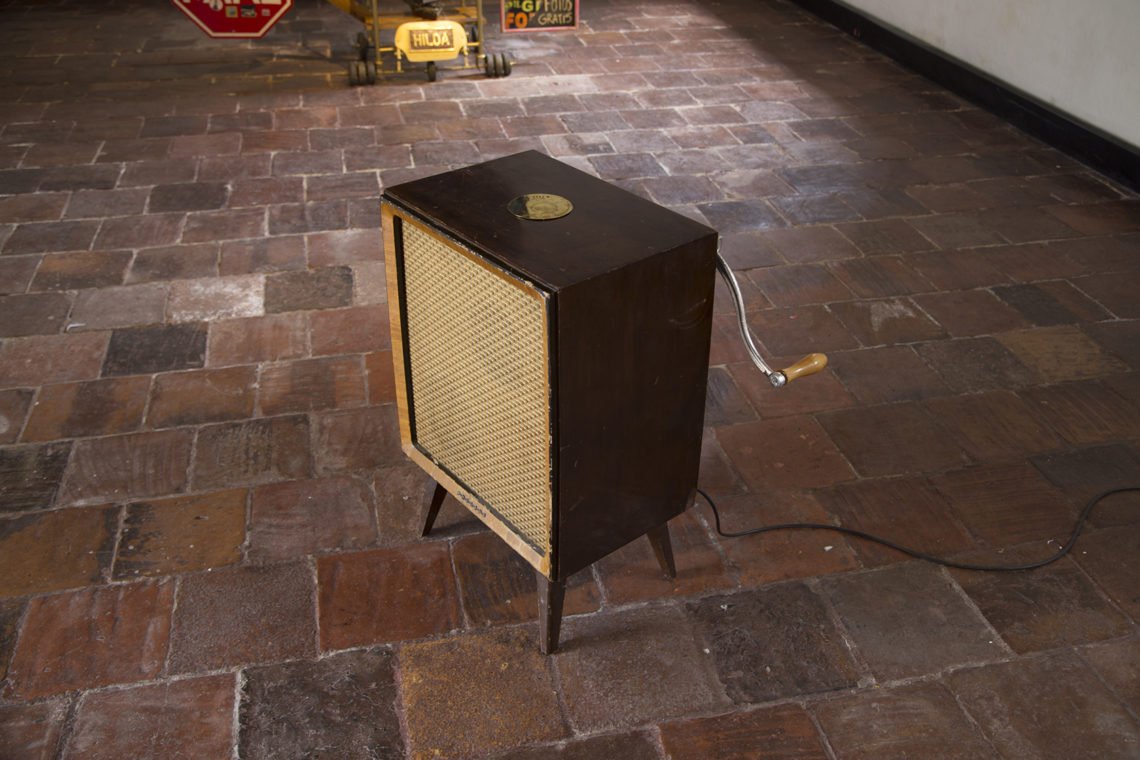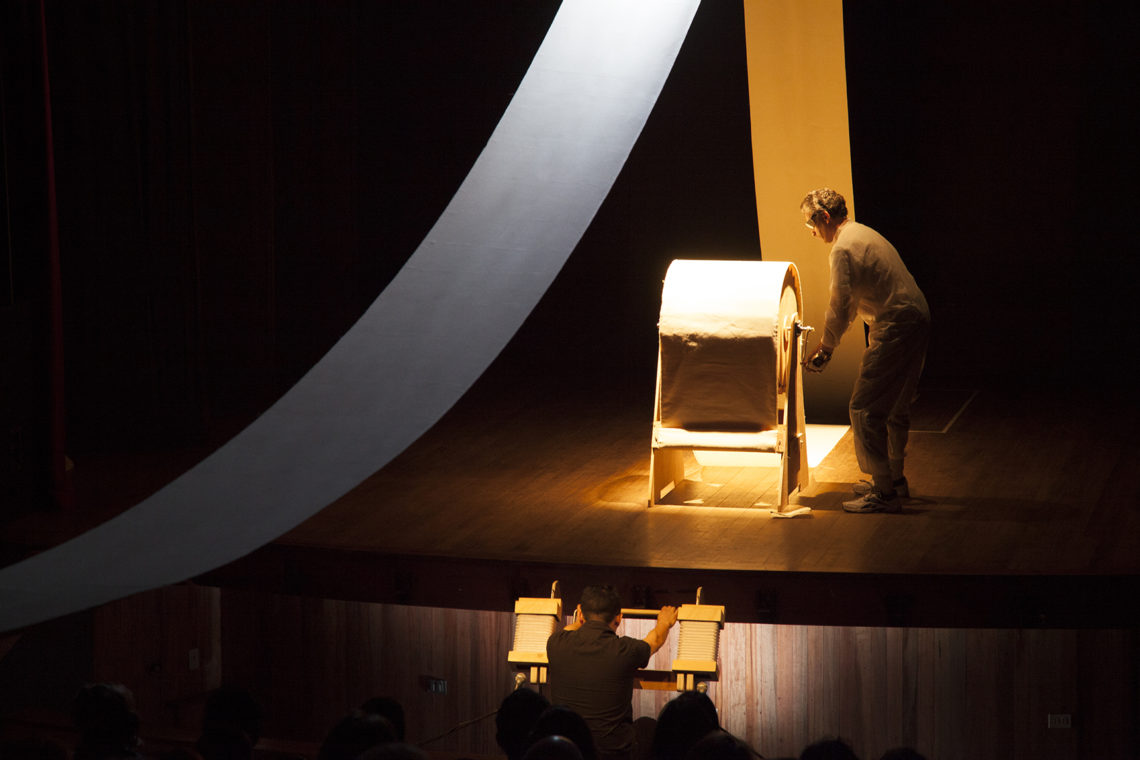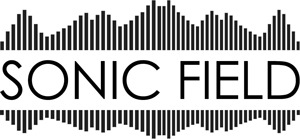
Julia Nanda Bejarano López is an artist from Colombia working in many interesting sound projects, and in Sonic Field we wanted to know more about them and the process behind.
Q. How and when did you identify sound as the field where you could develop your artistic ideas?
I grew up surrounded by music and sounds at home, all because my father is a composer and sound artist. He taught me to be sensitive to the world of sound. For me, it was quite normal to listen as I grew up and I played around feeling quite curious for anything that made noise.
Something that was quite definitive was actually whenever all the family went on vacation, or any other day, really, was that my father always had a recording device. He asked us to stay still for a while, to listen to the environment, and afterward, we would sit down to listen to those things he recorded. I found it very amusing and fun. I think that I effectively began to explore sound creation because I was drawn to what my father did. My toys where always some kind of musical instruments and the most mysterious and magical place at home was his musical composition study.
I think what I enjoyed doing the most during my childhood was listening and thinking of the sounds of the world as my own, as toys, even. That allowed me to open up to work with them quite easily as I grew up. I feel that was how I let go of the temporal and closed structures that bind sound before they can even be used, and I learned to not impose abstractions on matter but to allow matter to suggest the possibilities.
Before I started studying my Fine Arts undergrad in Bogotá, Colombia, I worked with sound through music, playing guitar and singing. I formed several punk and rock bands, and also I worked as a DJ, all with a particular interest for noise. Always tried to fill spaces with sounds to immerse ourselves in them. When I got into university, it was very natural and intuitive for me to explore sound –then from an academic perspective-. Once I graduated, I continued on that same narrative, slowly learning, and I really do fall in love more each day with the possibilities sound brings. I feel like it’s become a part of me. I don’t feel as if my creative process has a set idea that becomes a sound. Most of the time the idea is the sound itself, and it’s the art-making which allows me to come up with questions for it. Sound became one of the most important aspects of my life because it gives me meaning and well-being, and it’s the material that I use the most in my work as an artist, assuming it as central in my practice.
My creative processes through the world of sound are about creating different object-based, reflective, poetical, and practical experiences and proposals. All this with a specific interest in direct and physical work with sound objects, how they behave in specific spaces and how I can change their meanings and uses through sound, as well as an interest in listening and recording the soundscapes of the world. I also work in electroacoustic music composition. Likewise, I write essays that are the result of various research papers on artistic creation, listening and the world of sound. And at this time I am really keen on the relationship between the symbolic, the scenographic and sound.
Q. From your experience, how do you feel gender issues are reflected in sound art? Do you feel there is a kind of predominance in particular? If that is the case, have you seen that as an advantage, a disadvantage, or does it have no influence whatsoever?
In terms of my direct experience as an artist, and taking into account the circles I’ve worked and moved around in -which are not too big-, I do feel there’s a masculine predominance, and I know this has a series of complex explanations that are tightly wound around each other. For example, we have to talk about education, family upbringing and overall social institutions. We have to understand how we’ve learned and how we project art history, art story and art stories in our work. It’s important as well to be aware of who are the agents in the field, the relationships they’ve built, and the context of their actions. What I mean is that perhaps, in general, it’s a problem that we are not particullary aware of in this specific field. I also think as well that there are many artists who work specifically on these issues through sound creation and it would be very interesting that every listener and artist thinks about gender from art.
If I take a moment to think about how easy it is for me to listen to music made by women, I realize it is not difficult, and in my personal experience, being a woman has not been neither an advantage nor a disadvantage. At least from what I can perceive. In fact, any obstacles or hindrances I’ve had in the field have been of a different nature.
Having said all this, composing implies listening to others, and listening implies understanding. If there are problems in our creative spaces around gender issues, it’s because we’re not all listening.

Q. Sometimes the link between what an artist reads, researches, eats, sees and hears, and the work created is quite intentional, while sometimes this link is much more subtle if not done unconsciously. What about your work?
All human beings are sensible one way or the other, it’s part of the human condition, but there are certain life experiences or career choices -academic or not-, in which this sensibility is explored and expanded much more. I think one of those is being an artist. One accepts that this sensibility is active in every moment of our lives and that everything we feel is a possibility, and that whatever goes through our mind and bodies has an influence on what we do as creators.
Regarding my work, those influences manifest themselves according to the project or creative process I’m carrying out at the time. Which is to say, the consciousness of them or their deliberate condition is different each time, since I think I’m a person who is constantly changing. There are situations I build up taking into account every axis of work, and there are many others where things just flow without myself asking the whys and the hows of what I’m making. There can be lengthy processes as well as extremely brief ones; there are plans that end up working and some that don’t. And some processes in which stuff comes forth by chance. And most of the time you get the idea of these processes just by living and not actually working on a particular thing.
It’s also worthy to say I don’t know what the ‘creative process’ is… I can’t put my finger on it, but I think that this sensibility is perhaps most evident when I guide myself through my first ideas or intentions, and I choose to trust them without overthinking any fresh reactions that I may have when I want to do something. And these are the kind of manifestations that come to be when one is engrossed in whatever is taking up your time.
If I think of a particular process I’ve carried out as an artist, you can see what I’ve been saying in my relationship with the sound of breathing. Breathing is the most ordinary and constant thing you do in life, and it has been the sound I’ve paid the most attention to. It’s a staple of my piece Gira, respira y escucha: La Máquina de Ulular (Turn, breathe and listen: the wind machine), which was a sound event at Teatro El Parque in Bogotá which used two machines that were reminiscent of those used to make sound effects in XVIIth century theater: the wind machine and the breathing machine. – https://circuloa.com/la-maquina-de-ulular-de-julia-nanda-bejarano-lopez-2015/ –; as well as essays like Vida, escucha y creación sonora a partir del sonido ordinario de la respiración y del silencio y su relación con el arte (Life, listening and sound creation from the ordinary sound of breathing and silence and its relation to art), published in Cuadernos magazine of the Javeriana University of Bogotá. – https://revistas.javeriana.edu.co/index.php/cma/article/view/20420 – in exhibits such as EXHALAR (TO EXHALE) which took place at Neebex Gallery in Bogotá. In this exhibition I set up a sort of imaginary kitchen/lab with experiments with wails, sighs and blowing sounds – https://circuloa.com/exhalar-de-julia-nanda-bejarano-lopez-2018/ –; in installations such as Célula (Cell) at the Gilberto Alzate Avendaño Foundation (FUGA) in Bogotá, I explored the sound impressions of my voice through a speaker layout in the space, hand alphabets and cellular idea of organisms, words and sounds; as well as musical compositions such as Respiración Imaginaria (Imaginary Breathing), which premiered during Nuit Blanche at the Festival Futura in Crest, France.

(Exhalar)

(Célula)
Q. How are the following aspects of aesthetic sound practices used in your work:
a) Immediacy and the face-to-face act of performance in concerts.
There is something very characteristic of sound: its ephemeral nature. It’s like it’s happening as it disappears. Therefore immediacy and briefness are things that are always present in my work, and from that the need for presence, although I don’t see it as a fixed rule. When I think of performance, I tend to think about the body, and I feel my body is not what’s most important when I conceive my sound performances in shared spaces. Instead, I think about the performative body of the audience, which is to say, my work, in any of its forms -concerts, installations, exhibitions, objects, essays, among others- are open sound events.
b) The process of composition that can lead to isolation and retreat
Lately, I feel that the time I can arrange to concentrate on my creative process is not much. That’s why I get the feeling that, as for retreating, I can’t really go away that much when I’m already coming back. I’m still a person that works very quickly -and I know it sounds arbitrary-. I can’t stay focused on a single project for very long unless I believe the task itself requires it. Maybe in the only processes I can truly isolate myself from it all is when I compose electroacoustic music -not necessarily when I’m editing or working on sound installations or objects- I do need, even for a brief moment, set spatial conditions I can control and concentrate. I can’t easily achieve that; I have to struggle with myself. I consider that if you work with sound, isolation is essential to exploring and understanding certain sound experiences.
c) The objective and spatial nature of the exhibited sound installation or sculpture
It’s what I do most in my work: set up the space, shape it, create it. For me, space is everything; it’s what’s most important, I always have to keep it in mind, work with it, start off from it. It’s not about imposing matter in a box but about understanding all there is and how it can be shaped, usable: is poetic matter. To make objects and lay them out, add to the sound imagination that they only recently did not have, to change the sound possibilities of the space and the audience. To generate immersion, texture, and poetic relations. In Entretierras (Between Lands) a fishing net contains inside it speakers that play out the sounds of all the words that name all the rivers of Colombia. – https://vimeo.com/291535714 – In Mundo Raro I attached a lever to a speaker from the 1940s that when turned, plays back the same song, ‘Un mundo raro’ by Chavela Vargas.

(Mundo raro)
Q. Do you think being a woman working with art and sound in Latin America influences your creative output in any way? If so, how does it come to be?
I don’t think it’s easy to explain. Thinking in broad artistic terms, sometimes when I hear sound art made by women – not always though -, there’s this I-don’t-know-what that is absolutely local and close, and there could not be anybody else that wasn’t a woman living here who could have done it. There is a closeness that stirs, that you can feel. Despite this, sometimes I think that, for example, in electroacoustic composition, there isn’t a clear historical precedent for Latin American creators since we don’t have that much creative baggage, nor a robust academic tradition or structured models inherited from any particular line of thought. And most of the time I can’t feel that thing that makes me think a woman was behind of something I’m listening to.
When I think about Latin America, I think about freedom. Always knowing that it’s a complex thought. In my sound piece, Todo suena como los pájaros (Everything sounds like birds) I felt that freedom was manifest – which I do admit do not know what it entirely means – and I realized it only after crafting the piece, specifically, through the comments made by judges at the Découvertes Pierre Schaeffer de Phonurgia Nova awards in Paris –prize that I am very honored to have won–. When I composed it, I wanted to be generous, to feel at home, to feel alright. I wanted to compose with sound material that came from soundscapes of my own personal archive – not all of the sounds I used where from Latin America -, and even thought it’s anecdotal yet narrative material, I used it as pure sound material, musically. Anything can sound like birds because in the end, the sounds of the world are as many as there are birds in it. That is freedom.
Q. In sound art, collaborating with other artists is very common. Have you worked with other creators? What can you tell us about these experiences?
I think that the collaborations I’ve been a part of have taken their time. They require depth and seriousness, and the few I’ve participated in have been truly special for me. It’s important to work with others, to listen to ourselves, to find new imaginations. It’s quite beautiful. Gira, respira y escucha: La Máquina de Ulular (Turn, breathe and listen: the wind machine) was an, in essence, a collaboration. From the conception of the event, which was during my residency in La Cala –Casa Abierta La Andariega– in Chodes, Spain- https://lacala.es/historico/julia-bejarano-lopez/ –, up to all of those who participated the day of the event: the announcer: Ricardo toledo Castellanos, the performers Federico Demmer y Julián García, and the stage technicians. What I did was to establish some starting points, some basic instructions, and left generous space for experimentation to each of the collaborators – https://circuloa.com/la-maquina-de-ulular-de-julia-nanda-bejarano-lopez-2015/ –. In Hipónimos de silencio (Hypnony of silence), I carried out a collaborative action with Colombian artist Alejandra Bonilla. For this sound event, centered around those sounds that as hyponyms connect with silent matter and its relationship with the world of words and communication. Bonilla played a typewriter that was amplified through the space using contact microphones, while I spacialized these sounds along with another sound piece in the auditorium.

Q. Is there any work or project of yours you’d like to tell us about?
During the past year I studied scenography design trying to find a new sound universe there, and I did. At this moment I’m developing my first theater play, something that I still don’t exactly know how will be because it is new for me. I am exploring the links that can be found between an acousmatic concert, a play and dance all set in a single event and place. It’s called Jardín Solar (Solar Garden), and it’s formed by the poetic relations between the sounds of a gong, sunflowers, and two characters: a woman gardener and a ghost. I intend to explore up to what point can you represent and present at the same time, and in a theatrical context dislocating a possible linear and predictive narrative of unrequited love, the framing of the experience as if it were a concert of electroacoustic music. I’m interested in exploring the temporal organization of all the elements in a single place, and how these can build up the sound space from different gestures: body movement, symbolism, sound, acting, instruments, scenography.
To know more about this artist check the following links:
https://issuu.com/juliabejarano
https://vimeo.com/user39594498
https://soundcloud.com/julia-bejarano-l
https://www.instagram.com/juliabejaranolopez/?hl=es-la
https://circuloa.com/la-maquina-de-ulular-de-julia-nanda-bejarano-lopez-2015/

